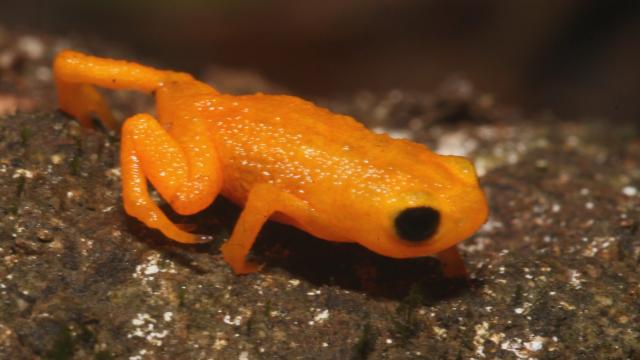Scientists in Brazil say they’ve discovered a new species of poisonous toad — hidden in plain sight due to its close resemblance to another related species. Aside from their tiny size, the wee toads have brightly coloured skin and bones that fluoresce under UV light, a feature that still isn’t completely understood.
Study author Ivan Sergio Nunes Silva Filho, a zoologist at São Paulo State University, and his colleagues have been studying the biodiversity of the Brazilian Amazon for some time. Part of this work has involved untangling the genus of amphibians known as Brachycephalus. Not all toads and frogs in the genus look alike, but they’re all miniaturized, compared to the average frog we’re familiar with, with the smallest species being no longer than 1 centimeter front to back. Many also have very similar and sometimes poisonous orange skin, leading to their nickname of pumpkin toadlets (the more brownish ones are called flea frogs and toads).
In the past five years, 15 possible new species of Brachycephalus have been identified by scientists. One species in particular, called Brachycephalus ephippium, is found throughout Brazil. But researchers like Nunes have wondered whether some of these sightings of B. ephippium might have actually been of other related species that have gone unnoticed.

In their new paper, published in PLOS One on Wednesday, they argue that they’ve discovered one such hidden species along the Mantiqueira Mountains and forests of Southeastern Brazil. They’ve decided to name it Brachycephalus rotenbergae, after Elsie Laura Klabin Rotenberg, founder of Projeto Dacnis, a non-governmental organisation dedicated to conservation of the Brazilian environment that helped with their research.
“The species in this genus tend to have very similar morphology [the shape, size and structure of an animal]. So we need several pieces of data to make sure this discovery is valid,” Nunes told Gizmodo by phone. “For example, in the study, we looked at their genetics, their external and internal morphology — even the sounds the frogs are making — and found there were some real differences that would make for a full species status.”

On the genetic level, these toadlets seem to be about 3% per cent genetically different from B. ephippium, and up close, there are subtle differences in their appearance. B. rotenbergae toadlets have faded dark spots on their skull, for instance, which aren’t seen in other related species. Their mating call also appears to be just a bit different than other species.
“One hundred, even 50 years ago, it was very easy to describe new species. But now, we have to do a lot more work to describe these very similar species,” Nunes said.
There are a lot of mysteries about pumpkin toadlets in general. A few years ago, scientists discovered that some species had bone structures that are fluorescent in UV light — an attribute that this new species shares. But as with many fluorescent animals, it’s not clear what purpose it’s supposed to serve. Some have theorised that the fluorescence is another way to warn off predators wary of biting into a poisonous treat. But it may also be a useful tool for toads to recognise each other, according to Nunes.
Another strange feature is their mating call. These toads, due to their tiny size, are thought to be incapable of hearing the higher-pitched call from other toads. Yet, despite this deafness, they keep making them. Over time, Nunes said, it’s possible this vestigial attribute will fade away. But other experts have said that it may remain simply because there’s no pressure for it to go away as they evolve, since the toads are so poisonous that predators often don’t go near them, no matter how obviously they are calling out.
While some species of Brachycephalus, like B. ephippium, are plentiful, others are in serious danger of being wiped away, due to their small populations and the ever-continuing encroachment into their habitats by people. So Nunes and his team plan to continue studying this new species to better understand its ecology and fascinating biology.
